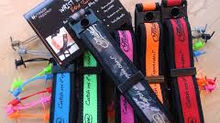Wrist Sling? What's the Point?
- Boss Crewmember Eli Rooney
- Jun 23, 2016
- 2 min read

You know those colorful, often made of paracord, slings people put on their bows? Don't they just strap them on for looks and so they don't accidentally drop their bows?
The answer is yes, but it's more complicated than that.
Here's why:
The design and intent of a wrist sling, or in some target cases a finger sling, is to relieve the shooter of the fear of dropping his/her bow because of the minimal grip of the bow hand.
The key here is that there IS minimal grip. Why? As research has shown and what I have found in my own personal studies/research projects is that archery performance scores increase with lower levels of muscular interaction with the bow.
If we redefine what a bow is through an engineering definition, it would sound something like this: A bow is a mechanism that utilizes the engineering of materials and/or cam technology to store potential energy that is released as kinetic energy to fire a projectile(an arrow) at an intended target. Many would agree to this definition. If you, the reader, also agrees to this statement, then ponder this question: Assuming the previous definition, how is the human involved with the mechanism of the bow?
Ok, so the human is necessary to draw the bow and aim it before being released, but why does the shot not always hit it's mark? The tolerances in the bow should make misses negligible, granted in this case we will assume there are no equipment failures, when fired from a shooting machine such as Spot Hogg's Hooter Shooter. BUT.....by putting the bow in a humans hands, we then are instigating error into the equation. Therefore, if the human is implementing error on the machine, we should attempt to rid the machine of all possible error caused by the shooter, right?
The human is only a means to draw the bow, aim, and release the string. That being said, body posture, grip, release angle, stance, and follow-through now become absolute essentials in reducing torque or other stresses acting on the bow throughout the shot cycle. The wrist sling, in this case, is an example of allowing the shooter to not fully grip the bow let alone at all so that there is less touching surface as well as pressure points on the grip of the bow. Because the grip is now reduced, the bow will remove itself from the hand as part of the shot but will catch by the wrist sling well after the arrow has cleared the string and shelf.
There are so many ways that the musculature in our bodies can cause force moments on the bow, and some may seem difficult to comprehend. If you'd like to learn more about reducing these effects or human interaction in attempt to improve your consistency of shot, I highly recommend lessons or visiting your local Archery Pro Shop. Most certified instructors and pro-shop employees understand the importance of minimal interaction, and can assist in helping you with your form to execute better results.
Separate the human from the machine;
as long as you do your job, the bow will as well.
Keep shooting!
Eli


















































Comments